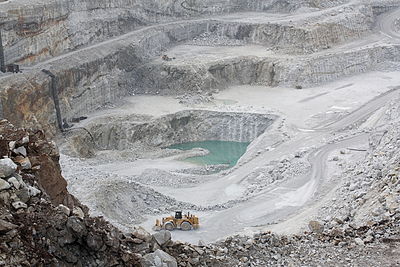- Lime (material)
-
For other uses, see Lime (disambiguation).
Lime is a general term for calcium-containing inorganic materials, in which carbonates, oxides and hydroxides predominate. Strictly speaking, lime is calcium oxide or calcium hydroxide. It is also the name for a single mineral (native lime) of the CaO composition, occurring very rarely.[1] The word "lime" originates with its earliest use as building mortar and has the sense of "sticking or adhering."[2] Lime can also refer to a sticky substance (birdlime) smeared on branches to catch small birds.
These materials are still used in large quantities as building and engineering materials (including limestone products, concrete and mortar) and as chemical feedstocks, among other uses. Lime industries and the use of many of the resulting products date from prehistoric periods in both the Old World and the New World.
The rocks and minerals from which these materials are derived, typically limestone or chalk, are composed primarily of calcium carbonate. They may be cut, crushed or pulverized and chemically altered. "Burning" (calcination) converts them into the highly caustic material quicklime (calcium oxide, CaO) and, through subsequent addition of water, into the less caustic (but still strongly alkaline) slaked lime or hydrated lime (calcium hydroxide, Ca(OH)2), the process of which is called slaking of lime.
When the term is encountered in an agricultural context, it probably refers to agricultural lime. Otherwise it most commonly means slaked lime, as the more dangerous form is usually described more specifically as quicklime or burnt lime.
Contents
Lime production process
- Limestone is extracted from quarries or mines.
- Part of the extracted stone, selected according to its chemical composition and granulometry, is calcinated at about 1000°C in different types of kiln, fired by such fuels as natural gas, coal, fuel oil, lignite, etc.
Quicklime is produced according to the reaction: CaCO3 + heat → CaO + CO2. Lime is used extensively for waste water treatment with ferrous sulphate.
- Quicklime can be hydrated, i.e., combined with water.
Hydrated lime, known as slaked lime, is produced according to the reaction: CaO + H2O → Ca(OH)2
See also
- calcium oxide, the main component of dry mineral lime.
- calcium hydroxide, the hydrated form.
- gypsum: a similar mineral.
- sascab: a building and paving material (Central America).
- hydraulic lime
- Lime plaster
- Lime mortar
- Lime wash
- Plastering
References
- ^ International Mineralogical Association: Commission on New Minerals, Nomenclature and Classification; Database online at http://pubsites.uws.edu.au/ima-cnmnc/ . Accessed 20 Sept 2011.
- ^ http://www.etymonline.com/index.php?term=lime
- J.A.H. Oates, Projet de. Lime and Limestone – Chemistry and Technology, Production and Uses. Wiley-VCH, ISBN 3-527-29527-5 (1998)
- US Geological Survey
External links
Categories:- Building materials
- Calcium minerals
- Oxide minerals
- Limestone
- Alchemical substances
- Plastering
Wikimedia Foundation. 2010.

